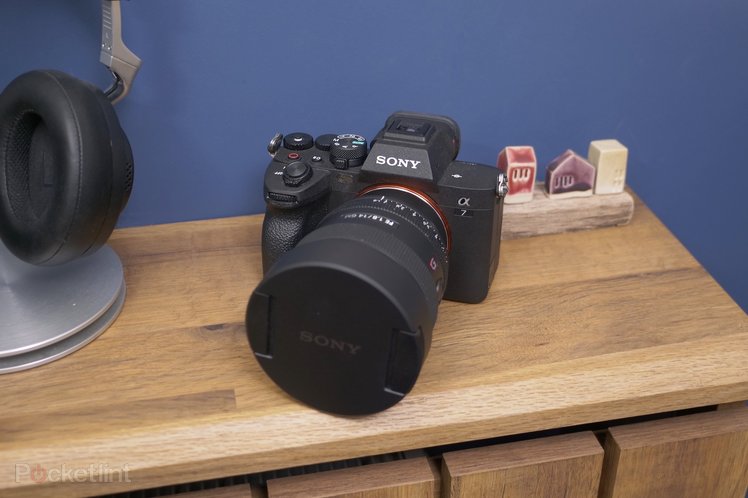
For close to a decade, Sony’s Alpha lineup has been the choice of many filmmakers and creators.
The reason for this is simple: these cameras offer great performance in a compact form, essentially giving you a really high-end tool that’s also easy to carry around.
In the full-frame market, everything began with the Sony A7’s release in 2013. And with 2018’s Sony A7 III continuing the line’s legacy as being the mirrorless all-rounder range to consider, how does the A7 IV stack up?
Well, one thing is for sure – it’s not cheap. As Sony has proved many times before, though, value is best found in the performance and feature set.
Design
- 131.3 x 96.4 x 79.8 mm
- 658g body weight – including the battery and SD card
- E-mount for interchangeable lenses
We’ve long enjoyed the compact form of Sony’s full-frame offering. While the A7 IV isn’t tiny – not to the levels of the A7c, at least – it’s still compact and easy to carry around.
It’s not really any bigger than Panasonic’s micro four-thirds cameras, like the GH5 and GH6, and yet still fits in a full-frame sensor.

It feels sturdy and well-made, too. The chassis is solid, with a reassuring heft, although, even then, it’s light enough that it’s easy to use handheld. This is helped further by the generous size of the grip that protrudes out of the front, and is coated in grippy rubber to ensure you don’t drop it easily.
There are a load of buttons and dials dotted around the body, as well, which is useful. However, because it’s Sony, these are also a little inconvenient. Some just don’t seem to be particularly well placed. For instance – in classic Sony style – the ‘Menu’ button isn’t within easy reach of the right thumb. It sits to the left of the viewfinder, instead.
So if you’re gripping it with your right hand, there’s no way you’ll get to the main menu without using your left.
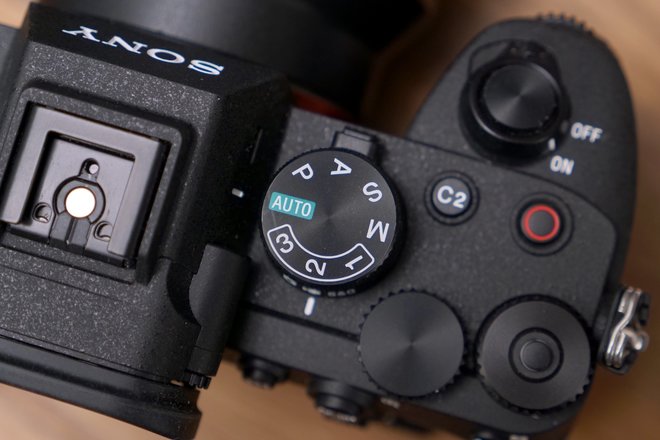
Other dials and buttons are quite a lot more convenient. Then there’s the dial for switching between photo, video and Slow & Quick modes, which sits beneath the shot preset dial. It’s fine really, and the fact it’s locked by default means you won’t accidentally switch to ‘Photo’ mode when shooting a video.
Behind that are two more dials which, when set in manual mode, adjust the shutter speed and exposure compensation by default. There’s also a grippy little directional joystick on the back that lets you adjust the focus point manually when in autofocus mode. Add that to the four programmable custom function buttons, directional navigation wheel and the dedicated movie button, and you have pretty much anything you need.
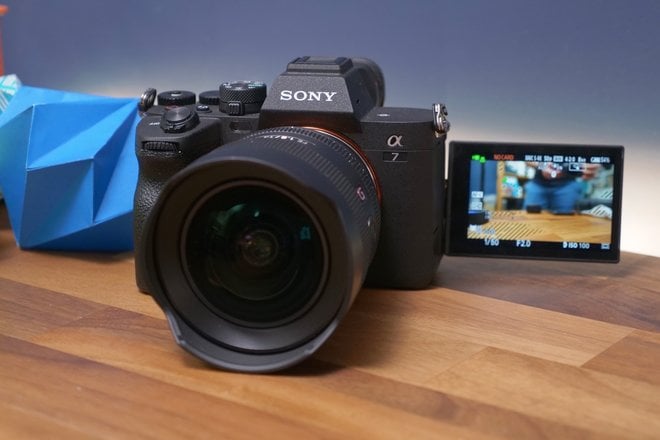
Thankfully, the days of Sony not adopting a proper flip-out screen are behind us. The A7 IV has one.
That means you can flip it out to face the same direction as the lens, making it easier to film yourself. It also rotates about 270-degrees to face forwards or backwards, or have it face down for those times you shoot while holding the camera up above your head.
The only issue with that flip-out screen is that it does block the ports a little when it’s facing forward, preventing easy access. Plus, if you’re actually using those ports while filming, you’ll be blocking the view of the display.
Ports and connectivity
- Dual memory card slot – SD and CFExpress Type A
- HDMI, Type-C (with Power Delivery), 3.5mm input and output
- 2.4Ghz/5Ghz Wi-Fi – Bluetooth LE
It’s 2022, and that naturally means any self-respecting camera maker ensures you have enough ports to make it useful for video capture. For Sony, that means 3.5mm input and separate 3.5mm output for microphones and headphones respectively.
There’s a USB-C port for connecting to your computer for file transfer, but, crucially, the A7 IV also supports Power Delivery for charging on the go. Then, of course, there’s the HDMI port for hooking it up to a monitor or external recorder monitor.
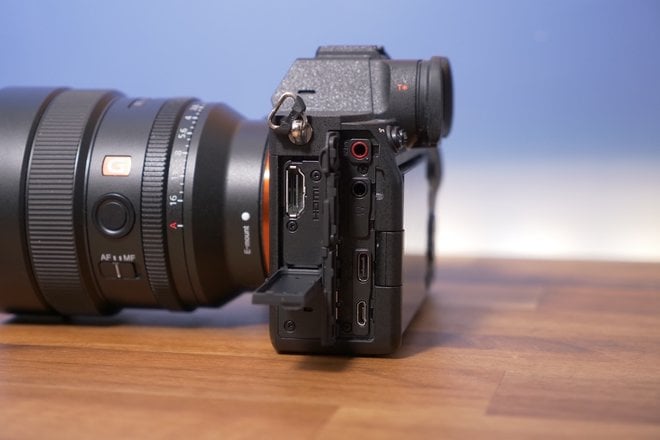
As for card support, you get two memory card slots. Both support SD cards, but the first slot is also compatible with CFExpressA, which is Sony’s own CFEpxress card format. It’s smaller than the kind used by Panasonic’s GH6, but it can read and write and faster speeds than SDXC. This is useful for the times you want to shoot in high bitrate file formats.
It’s also equipped with wireless connectivity via dual-band (2.4/5Ghz) Wi-Fi, as well, as low energy Bluetooth. This enables wireless file transfer and remote control function via your smartphone.
What is it like to use?
- Real-time AF/tracking for humans, animals and birds
- Breathing compensation
- 1.3cm electronic viewfinder (OLED)
- NP-FZ100 battery
Like any camera, a big part of what affects how the camera feels is impacted by the lens you use with it. Given that Sony sent us a prime, wide-angle 14mm f/1.8 lens, that did limit the experience somewhat. There’s only so much you can do with a lens that doesn’t zoom and, being wide-angle, isn’t always keen on focussing on close up objects.
However, while the lens wasn’t ideal for all scenarios, there are lots of things to love about the way the A7 IV handles itself, and a big part of that is the advanced sensor and processing makeup. Just as we’ve experienced with previous recent Sony cameras, the speed at which it operates is really impressive.
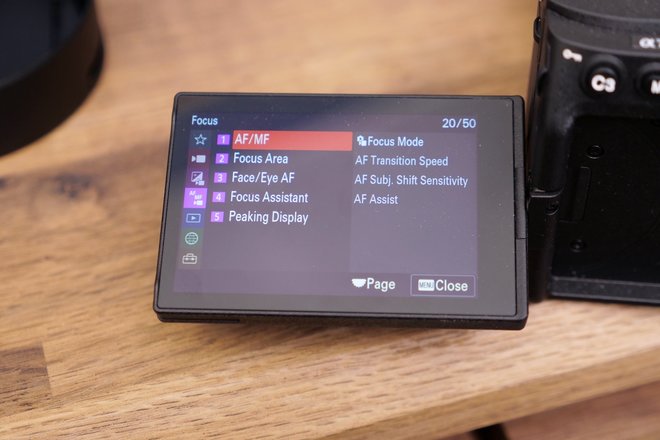
Stick it in autofocus and you’ll get eye-tracking in real-time by default. So, whether you’re shooting a person or an animal, if their eyes are in view, it’ll lock on and track them. And it does so reliably, too. If you want to manually track an object, you can simply touch it on the screen. It stays locked on whether it moves, or you move. For the most part, that works well.
For still photography, the speed at which it can lock on to an area and shoot a photo is really impressive. Sometimes it feels a bit too fast, and can actually start to feel like a trust exercise just believing the camera has focused on the right area.
There are a couple of elements that can make the Sony camera a little tricky to use, though, and they’re the same as we’ve seen in most recent models.
Firstly, the fact you can’t just press the shutter button to start recording a video seems unusual, especially when you have to be in the dedicated video mode to shoot it in the first place. Instead, you get told off by the A7 IV and instructed to press the tiny, fiddly red button instead.
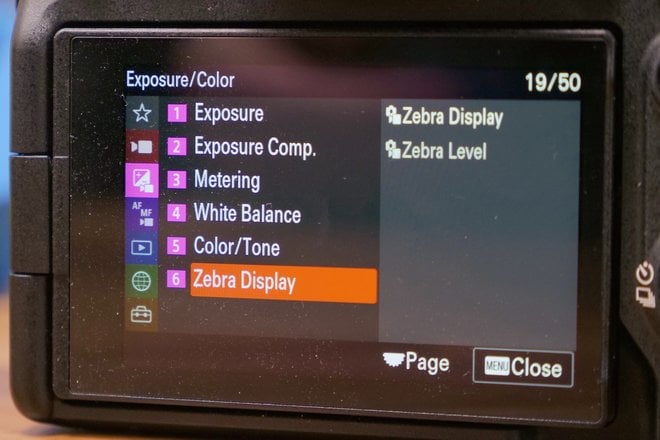
Secondly, Sony’s menu system in the software is hard to get accustomed to. There are so many options in there to customise the experience and settings, and, while this is a positive in some respects, it also makes it long-winded and unintuitive to navigate around.
Battery life is pretty strong, however, for a camera this powerful. We never found ourselves panicking about how long we could shoot for. What’s more, since it has USB-C that accepts power, you can plug it into a battery pack while on the move to top it up while you’re not using it.
Photo and video
- 33MP Exmor R CMOS 35mm full-frame sensor
- Bionz XR ISP – up to 10fps bursts
- 4:2:2 10 bit 4K/60 video
- 5-axis SteadyShot stabilisation
At the heart of the A7 IV lies the latest 33-megapixel Exmor R full-frame sensor, paired with the powerful Bionz XR image processing unit. It’s a great pairing, and, along with some clever thermal management, enables some high bitrate and high frame rate recording at 4K resolution.
It shoots 14-bit RAW, plus 4:2:2 10-bit video at 4K/60, and that means you can get sharp, smooth footage – especially when using the 5-axis stabilisation. Crucially for anyone who does a lot of colour correction, the 10-bit data also means you get a lot of room to tweak colours, balance, exposure, highlights and the like without losing detail or making the picture noisy.
On the subject of colour correction, you also get several picture profiles to choose from. These include S-Log2 and S-Log3, as well as a few different HLG modes for HDR capture. Those join a handful of Cine modes, and the usual standard automatic movie setting. If you want, you can even adjust and fine-tune your own custom preset, with the built-in screen offering a decent preview of what it will look like on a well-balanced monitor afterwards.
The end result with video is a colour-rich picture with sharp details and well-controlled exposure/shadows in automatic mode. It didn’t seem to struggle with anything, with the aforementioned autofocus and real-time tracking keeping subjects sharp.
With the F/1.8 lens, we were using it also meant some pretty dramatic depth of field, with some stunning, natural-looking bokeh/background blur. Of course, at its peak, that also meant a very narrow area of focus, but, with the right subject and in the right setting, it’s effective. For instance, when shooting products in a cramped space, it can help add some depth that otherwise wouldn’t be there with everything so close together.
We didn’t notice any significant issues with any of the footage or stills. Even in the shadows, or with slightly lower-than-optimal light levels, it can give good detail without excessive noise. And, despite having quite a wide-angle lens, the levels of distortion were low too.
